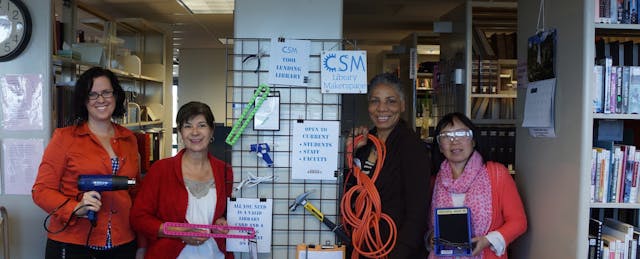The makerspace at the College of San Mateo (CSM) hosted a Salsa and Merengue workshop—a student led session on “making” dance. The space itself has the 3D printers, of course, and the Arduinos, but no technicians or dedicated classrooms. It’s a volunteer outfit, moving quickly in and out of library rooms on a Tuesday or Thursday afternoon. This community college relies on students, faculty, and local connoisseurs to guide the direction of the space. If no one leads a session, the makerspace disappears for a week.
Small, flexible "pop up" makerspaces like the one at CSM seemingly stand in the shadows of the $60 million, three-story, museum-style makerspace in the works at Houston Community College (HCC). But during conversations with Library Director Lorrita Ford of CSM and Vice Chancellor of Innovation Edmund "Butch" Herod of HCC, similar concerns emerge—about community, creativity, and experiential learning.
The higher education makerspaces of our cultural imagination are the FabLabs at Stanford, the Open Hardware Makerspaces at North Carolina State University, and the ThinkLabs at University of Mary Washington. They serve as collaborative spaces in which to gather with shareable tools for hackers, designers, engineers, and entrepreneurs. But community colleges, too, have made their own movement. Their “making” is informed by nearly half of the undergraduate students in the United States, by low retention and graduation rates, and by large percentages of part-time and noncredit students.
Making Community
If you sign up for a makerspace workshop at CSM, you won’t know whether your teacher is faculty, staff, or student until you show up in the room. This forms a community of practice, of equals. As Ford tells EdSurge, "I've always felt that the community college library should be a focal point and community space in the college." One student led a lesson on how to build the terminator bodysuit molds. A biologist directed a workshop on jewelry-making. An architecture student taught a class on how to build a geodesic dome out of straws.
The CSM makerspace isn’t a place where titles are revered, but experience with a subject is. It’s a break from the high stakes testing of the traditional classroom. You can fail here. You can try things in new ways. Says Ford, "I mean people are happy here. They're smiling—and forming relationships that are friendly and fun. It's a non-judgemental space." And she embodies this ethos, treating students as equals, claiming to be friends with many by name. The makerspace is a community hub for wide range of individuals, each treated equally.
Fostering Creativity
Ford and Herod argue that by bringing together a diverse and disparate community you can foster creativity. Herod explains, "People, I think, yearn intrinsically for ways to express themselves creatively. A person might not be able to draw a straight line but can go into a makerspace and build a cabinet off the bat.” These makerspaces provide the first step, he says. "The whole point is to get students interested in making and creating. They have creative impulses but don't have easy ways to channel them." Within the new HCC makerspace, there will be a tool to match each creative impulse.
Herod claims that the wide array of life experiences that community college students bring make community colleges the optimal place for creative emergence. He says “We're building on diversity—age, skills, life-experience, linguistic, everything." Nowhere else can you gather such a range of life experiences into one room. Creativity happens where collisions of perspective happen.
Experiential Learning
For Ford, the makerspace isn’t simply a resource for free workshops on Thursdays, but also a space for courses. One instructor taught a sculpture class, giving students the option to use clay or 3D printers, discussing the affordances of each. Anthropology students studied cultures by crafting Polynesian leis and workshopping African-American quilts. Says Ford,"What we're doing is training students to use critical thinking skills to solve problems, giving them tools they may be unfamiliar with." She claims there’s something about using your hands that stimulates the mind and relaxes you.
When Herod conceptualized the HCC center, he envisioned an experiential museum, even though, he tells EdSurge, “Everyone thought I was insane." Everything will be open. Glass walls will separate rooms. Students will be able to work on their projects and look through the wall to see other students tinkering. With so much action, interaction will follow. With tools for artists, carpenters, engineers, and entrepreneurs so close together, he hopes spontaneity will follow.
Ford and Herod keep coming back to the makerspace as a world where students can come together in community and create. For them, it’s an act of faith in the creative potential of a collection of students who aren’t attending the Harvards and Yales. They are at college for many reasons, with a myriad of life experiences, and a panoply of long term goals. Everyone can create. Everyone can make. These are the people fighting to democratize creativity.


